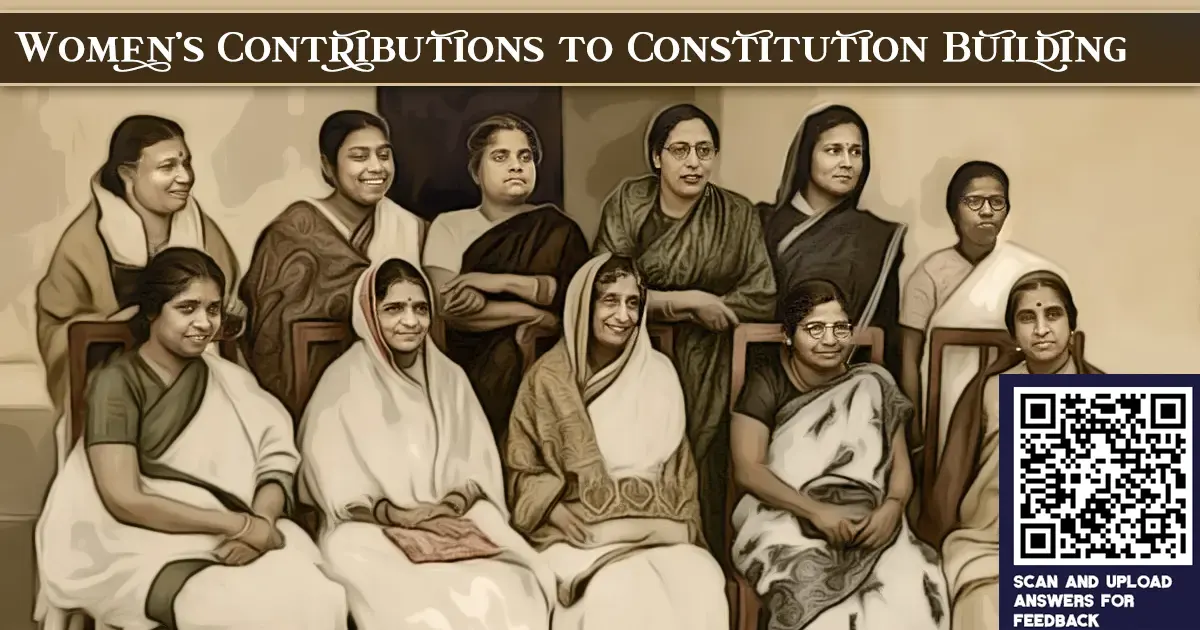
Context: As India celebrates 75 years of its Constitution, it is essential to acknowledge the significant yet often overlooked contributions of women in the Constituent Assembly, who worked alongside their male counterparts to shape the nation’s foundational document.
Need for Recognition
- Historical Oversight:
- The role of women in drafting the Constitution has been largely overlooked in mainstream narratives.
- Significance of Their Contributions:
- Women played a crucial role in framing fundamental rights, procedural rules, and policy frameworks that continue to shape Indian democracy.
- Inclusive Historiography:
- Recognizing women’s contributions provides a more complete and balanced account of Constitution-making.
- Balanced Perspective:
- It highlights the diversity of opinions and perspectives that influenced the drafting process.
- Inspiration for Future Generations:
- Honoring their work serves as an inspiration for gender equality in leadership and governance.
Key Contributions by Women Members
- Participation in Committees:
- Hansa Mehta and Amrit Kaur contributed significantly as members of the Fundamental Rights and Minorities Sub-Committees.
- G. Durgabai played a vital role in the Steering and Rules Committees, which managed the procedural framework of the Assembly.
- Shaping Key Articles:
- Amrit Kaur: Advocated for gender equality and opposed community-based reservations, emphasizing merit and fairness.
- Hansa Mehta: Championed the inclusion of fundamental rights and pushed for the implementation of a uniform civil code.
- Dakshayani Velayudhan:
- Criticized caste-based reservations, advocating instead for educational and social empowerment.
- Opposed discriminatory laws against women and expressed notable dissent on allowing courts jurisdiction over property compensation issues.
Challenges Faced by Women in the Constituent Assembly
- Gender Bias:
- Women often faced disrespect and interruptions during debates and were frequently relegated to the “back benches.”
- Discrimination in Debates:
- Renuka Ray faced heckling for opposing property rights favoring the elite and advocating for socialism.
- Male dominance often overshadowed female voices in critical discussions.
- Marginalization in Documentation:
- The contributions of women are not well-documented in the official Constituent Assembly Debates.
- Traditional narratives have sidelined the impact of women drafters.
- Systemic Bias:
- Instances like Jawaharlal Nehru dismissing socialist concerns reflect the broader gender and ideological biases within the Assembly.
Way Forward
- Scholarly Research:
- Encourage studies like The Founding Mothers of the Republic by Achyut Chetan to highlight the contributions of women in Constitution-making.
- Educational Inclusion:
- Incorporate the achievements of women drafters into school and university curricula to ensure future generations are aware of their legacy.
- Public Awareness:
- Promote the legacy of women in the Constituent Assembly through media, literature, and public commemorations.
- Gender Equality in Leadership:
- Use the struggles and successes of these women as a blueprint for addressing contemporary gender disparities in leadership and governance.
By recognizing and celebrating the contributions of these trailblazing women, India can ensure a more inclusive and balanced narrative of its constitutional history, inspiring future generations to continue the pursuit of gender equality in all spheres of life.
[box]
Analyze the contributions of women members in the Constituent Assembly of India, highlighting their roles in shaping key constitutional provisions and the challenges they faced in a male-dominated environment. How can their legacy inspire contemporary gender equality in leadership and governance?
[button color=”purple ” size=”medium” link=”https://forms.gle/Wzz7M6oVE4bQS8Ws8″ icon=”” target=”true”]Upload Answer[/button]
[/box]




